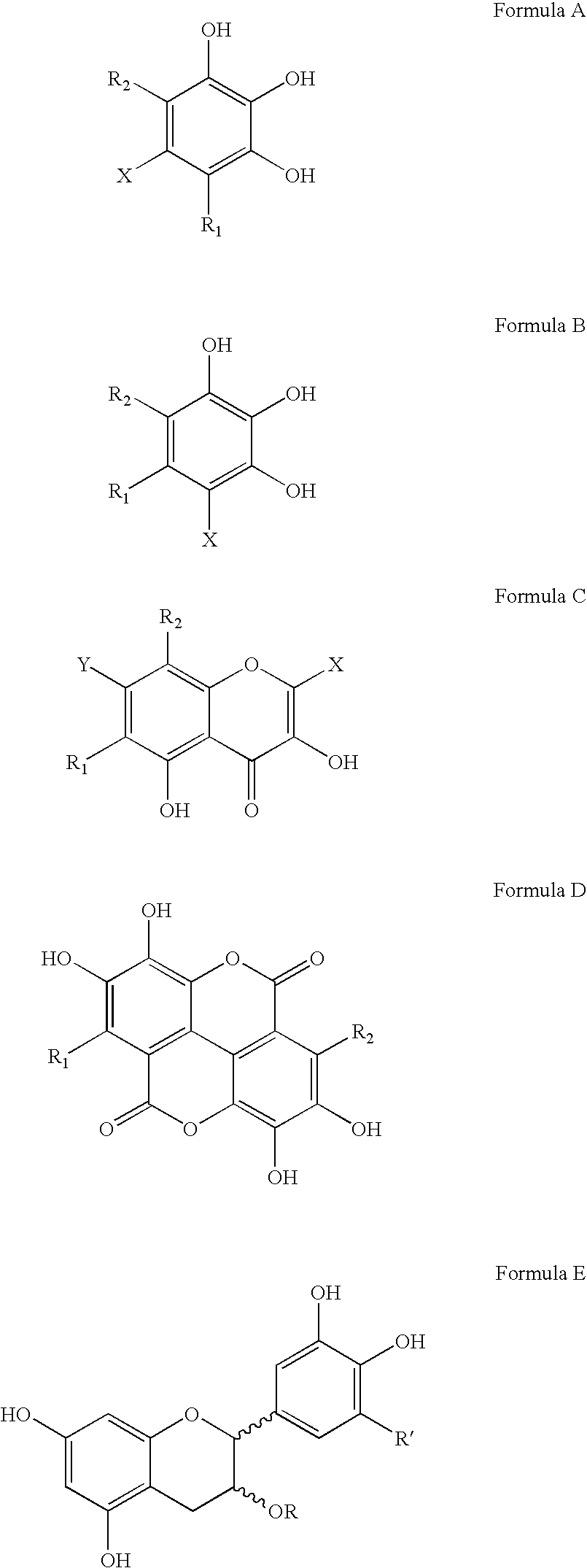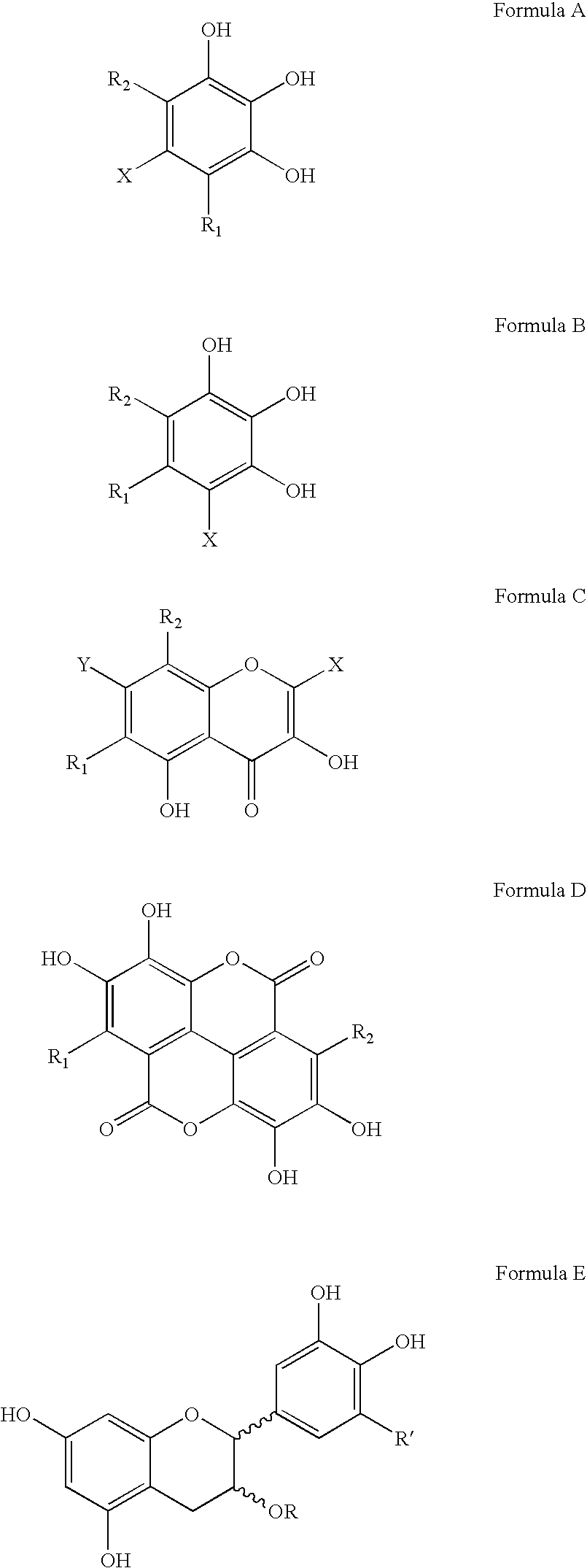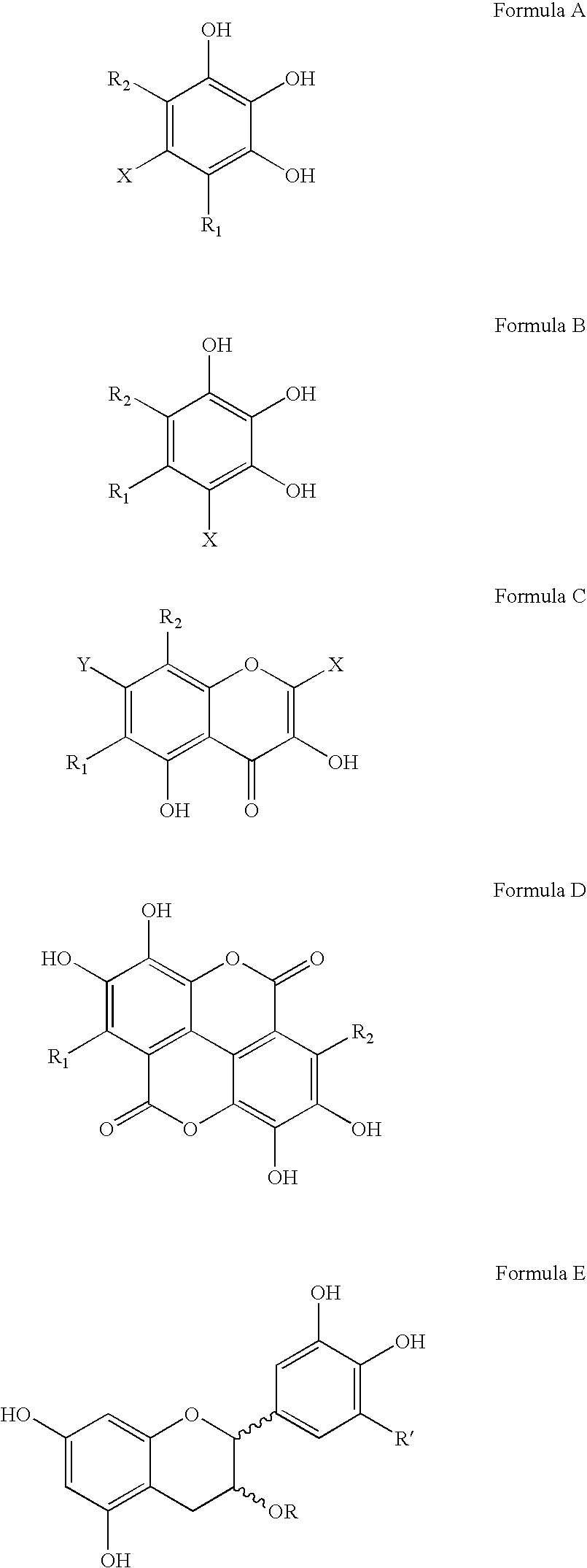Polyhydroxylated aromatic compounds for the treatment of amyloidosis and alpha-synuclein fibril diseases
a technology which is applied in the field of polyhydroxylated aromatic compounds for the treatment of amyloidosis and alphasynuclein fibril diseases, can solve the problems of renal failure, heart failure, and adverse effects of amyloid deposition on patients
- Summary
- Abstract
- Description
- Claims
- Application Information
AI Technical Summary
Benefits of technology
Problems solved by technology
Method used
Image
Examples
example 1
Disassembly / Disruption of Alzheimer's Disease Aβ 1-42 Fibrils by Polyhydroxylated Aromatic Compounds
[0096] In this study, different types of commercially available compounds which consist of various polyhydroxylated aromatic containing structures were tested for their ability to cause a disassembly / disruption of pre-formed Alzheimer's disease amyloid fibrils containing Aβ 1-42. This type of activity would be important for any potential anti-amyloid drug which can be used in patients who already have substantial amyloid deposition in organs and / or tissues. For example, Alzheimer's disease patients in mid-to-late stage disease have abundant Aβ-containing amyloid deposits in their brains as part of both neuritic plaques and cerebrovascular amyloid deposits. A compound capable of causing disassembly / disruption of pre-existing amyloid deposits would be advantageous for use in these patients who are at latter stages of the disease process.
[0097] For the first study, 1 mg of Aβ 1-42 (Bac...
example 2
Dose-Dependent Disassembly / Disruption of Alzheimer's Disease Aβ 140 Fibrils by Tannic Acid and Gallic Acid
[0104] In this study, the potential dose-dependent effects of tannic acid and gallic acid on disassembly / disruption of pre-formed Aβ 1-40 was assessed. In this experiment, 1 mg of Aβ 1-40 (Bachem Inc., Torrance, Calif., USA; Lot # T-20824) was dissolved in 1.0 ml of double distilled water (1 mg / ml solution) and incubated for 4 days at 37° C. to spontaneously induce fibril formation. 25 μM of pre-fibrillized Aβ 1-40 was then incubated overnight (˜18 hours) at 37° C., in the absence or presence of increasing amounts (25 μg / ml, 50 μg / ml, 75 μg / ml and 100 μg / ml) of tannic acid or gallic acid (each in the presence of 150 mM Tris HCl, mM NaCl, pH 7.0, with 0.02% sodium azide). The Aβ:compound weight ratios were therefore 4:1, 2:1, 4:3, and 1:1, respectively. 50 μl aliquots were then added to 1.2 ml of 100 μM Thioflavin T (Sigma) in 50 mM NaH2PO4 (pH 6.0) for fluorometry readings as d...
example 3
Disaggregation of Alzheimer's Disease Aβ 140 Fibrils by Polyhydroxylated Aromatic Compounds
[0106] In this study, a Congo red-Aβ spectrophotometric assay (Klunk et al., Anal. Biochem. 266:66-76, 1999) was modified to determine the effectiveness of polyhydroxylated aromatic compounds on the disaggregation of pre-formed Aβ 1-40 amyloid fibrils. For this assay, 1 mg of Aβ 1-40 (Bachem) was incubated for 4 days in distilled water at 37° C. to spontaneously produce amyloid fibrils. 25 μM of fibrillized Aβ 1-40 was then incubated in triplicate with various test compounds for 3 days at 37° C. in Tris-buffered saline (TBS)(100 mM Tris; 50 mM NaCl; pH 7.0, with 0.02% sodium azide), at an Aβ:compound weight ratio of 2:1. Following incubation, 50 μl of 360 μM Congo red (Sigma) in distilled water was then added to 250 μl of each incubation mixture, giving a final Aβ:Congo red molar ratio of 1:3. After 10 minutes, the absorbance at 405 nm (reference wavelength to account for the absorbance of Co...
PUM
| Property | Measurement | Unit |
|---|---|---|
| diameter | aaaaa | aaaaa |
| body weight | aaaaa | aaaaa |
| pH | aaaaa | aaaaa |
Abstract
Description
Claims
Application Information
 Login to View More
Login to View More - R&D
- Intellectual Property
- Life Sciences
- Materials
- Tech Scout
- Unparalleled Data Quality
- Higher Quality Content
- 60% Fewer Hallucinations
Browse by: Latest US Patents, China's latest patents, Technical Efficacy Thesaurus, Application Domain, Technology Topic, Popular Technical Reports.
© 2025 PatSnap. All rights reserved.Legal|Privacy policy|Modern Slavery Act Transparency Statement|Sitemap|About US| Contact US: help@patsnap.com



